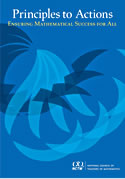While I certainly believe in the value of learning progressions, it seems that we can get too caught up in individual skills and overlook the big picture. I think of mathematical knowledge in terms of a "web" rather than a "ladder". Providing students with a rich mathematical task (defined by Jo Boaler and others as having a low floor and a high ceiling), students have the opportunity to use what they already know about mathematics to construct further knowledge. While the teacher has a learning target for the lesson, if students are allowed space and opportunity, they might connect mathematical knowledge that the teacher had not considered. Knowing learning progressions will help the teacher support the students in making connections and guiding them towards the learning target - but the students should be the ones making sense of the mathematics. This idea is interwoven throughout the Standards for Mathematical Practice when students are expected to construct viable arguments, look for and make use of structure, and make sense of problems.
A perfect example of this occurred last week during a course that I teach at Otterbein University. The students are working towards a 4-6 endorsement for mathematics. We were exploring Sums of Consecutive Counting Numbers. After defining the problem, here is a sample of what students discovered:
We looked at at numbers through 50 but you can get a sense of the problem in this chart. Students observed that for some numbers, such as 1, 2, 4, 8, and 16, we were unable to find consecutive counting numbers that would create those sums. Students also noted that some of the sums could be created in more than one way with consecutive counting numbers.
Then, a student made an observation that I had never heard. I have facilitated this problem with students in grade 3, 4, and 5, with undergraduate students, with graduate students, and with practicing teachers. Each time I think that I have heard all of the possible observations, someone surprises me by making an observation I hadn't seen before! A student thought of the consecutive numbers as blocks and visualized adding another column. She was using geometry to make sense of the problem - this seems like such a natural way to view the problem yet no one had ever mentioned it to me before!
After describing how she visualized the problem, students made a conjecture that they could find every other number beginning with 3 if they used 2 addends. They could find every 3rd number beginning with 3 if they used 3 addends and every 4th number if they used 4 addends. They thought this pattern might continue. I then asked them to consider why this pattern might exist. What in the structure of the numbers created this pattern? This led to another interesting discussion.My learning target for this lesson was to have the students engage in a rich mathematical task. I asked them to share the mathematical content they felt could be explored with this problem. They listed:
- finding sums
- divisibility
- looking for patterns/algebraic thinking
- exploring multiples
- problem solving




